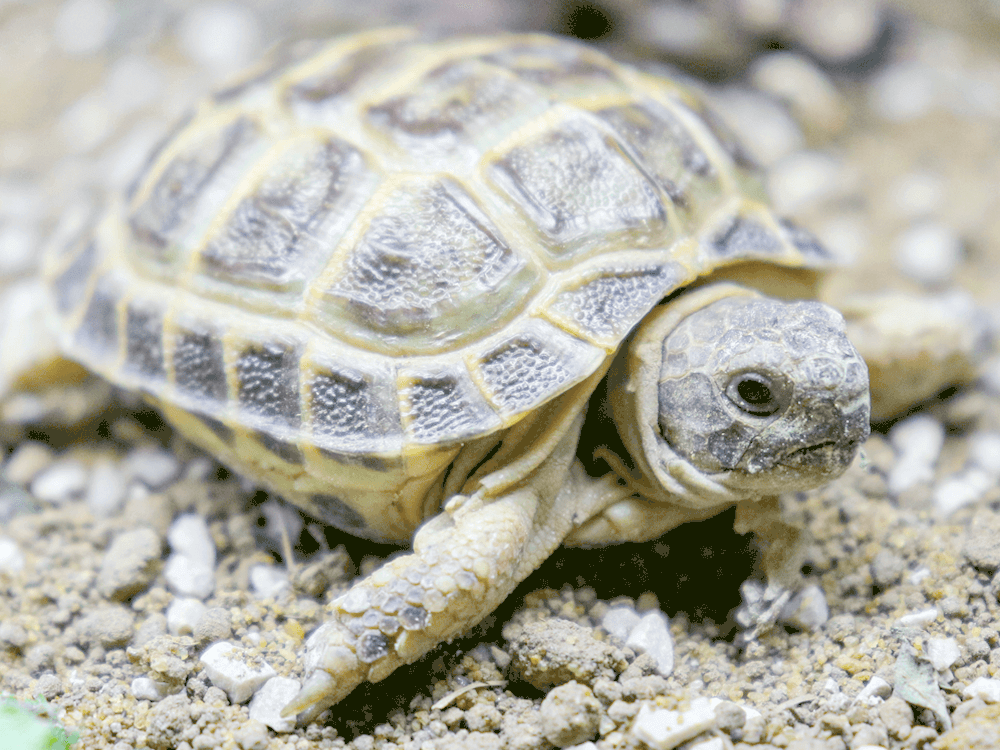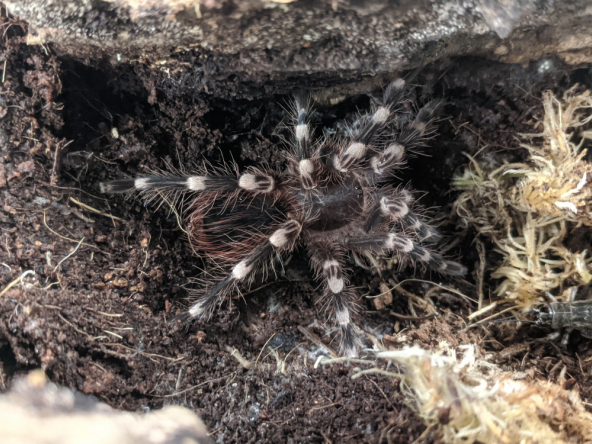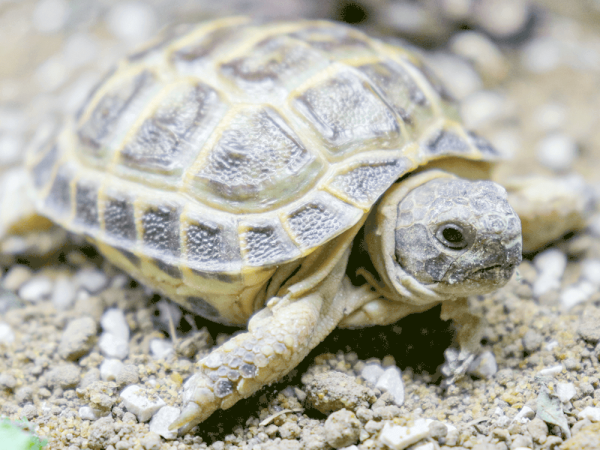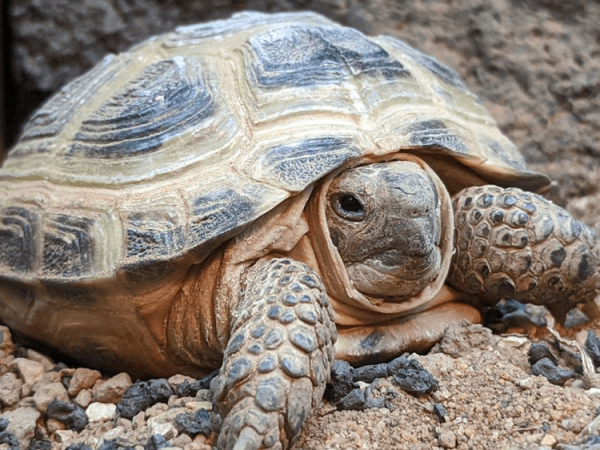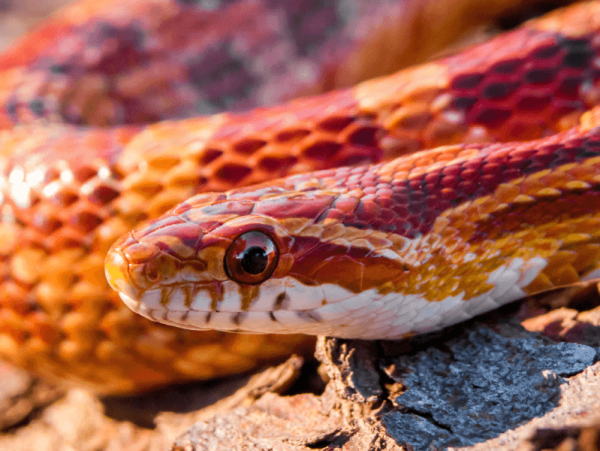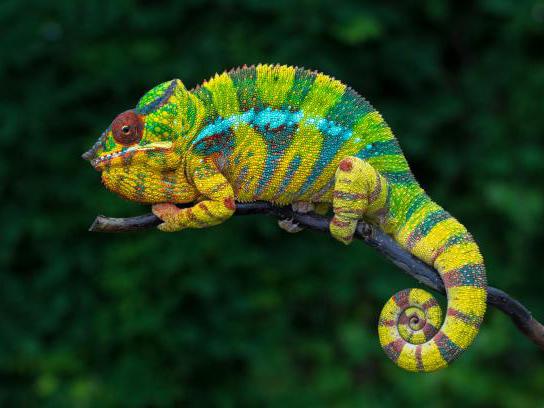Optional extras
Horsfield tortoise, Agrionemys horsfieldii, care sheet
Categories: Care sheetsChelonians
Horsfield tortoise natural history
The Horsfield tortoise, also commonly referred to as the Four-clawed or Russian tortoise is one of the most popular pet Tortoises in the UK. They are a small, hardy species that naturally inhabits a vast area spanning Central Asia, and as such inhabit a variety of different habitats from arid plains to mountainous areas. This species would naturally hibernate throughout the winter months to avoid the harsh, freezing temperature drops.
Male Horsfield tortoises tend to be a little smaller than females and have longer tails which they tend to tuck into the side of their shell. The shell colour of Horsfield tortoises is a variable colour of browns, black and yellow. The gentle disposition and hardiness of this Tortoise species makes them a great pet for beginner and experienced Tortoise keepers alike.
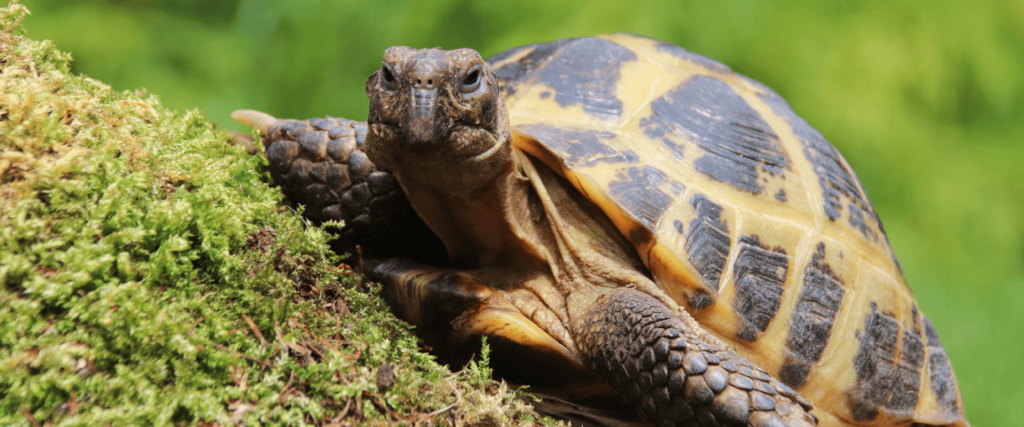
Horsfield tortoise enclosure
Horsfield tortoises, along with many other Tortoise species, are prone to developing respiratory infections in poorly-ventilated areas. For this reason, it is recommended that they are kept in an open-topped Tortoise table rather than an enclosed wooden vivarium. A wooden vivarium can be used for this species if additional measures are taken to increase ventilation, for example, by drilling holes in the top panel. We do not recommend permanent outdoor housing for Horsfield tortoises due to the difficulty in controlling the conditions.
Horsfield tortoises are natural roamers, so require quite a large amount of space to accommodate this behaviour. For an adult Russian tortoise, we recommend a minimum enclosure size of 150 x 90cm (5 x 3ft), although younger Tortoises can be kept in slightly smaller enclosures whilst they grow.
To simplify things, why not take a look through our Tortoise starter kits, ideal for getting everything you need in one go.
Horsfield tortoise heating and lighting
Russian tortoises are best kept with a temperature gradient that runs from around 30-32°C (86-89°F) in the basking spot to between 22-25°C (71-77°F) in the cooler end of the enclosure. They also have medium-high UVB requirements, best suited to a UVI between 3-4 to ensure good bone and shell growth and avoid serious health issues such as metabolic bone disease.
If you opt for the recommended tortoise table, heat and UVB can be provided by a singular source, a mercury vapour basking lamp. The required height of these lamps to produce the ideal UVI can differ between brands, so it is important to check the UV chart on the product packaging before set-up. Once you have the height range required to create the right UVI, you can move the bulb higher or lower within this range to create the ideal basking temperature (these lamps cannot be controlled by a thermostat).
If you decide to house your Tortoise in a vivarium, however, you will need to provide heat and UVB using separate sources, as mercury vapour lamps are likely to overheat in enclosed areas. Here, your heating system should consist of a heat bulb or ceramic heat emitter installed into the ceiling of the vivarium and hooked up to a compatible thermostat to maintain the correct temperature (dimming for heat bulbs or pulse for ceramic heaters).
The UVB lighting in a vivarium should come in the form of a T5 lighting kit, again installed into the ceiling of the vivarium. The required strength depends on the distance between the light itself and the top of the Tortoise's shell. If the light fixture will be between 30-40cm (12-15”) above the shell, a 6% T5 is a good option, however, if the fixture will be 40-60cm (15-24”) from the tortoise’s shell, a 12% T5 would be required.
Regardless of which type of heating system you use, you will need an accurate thermometer or two to monitor not only the basking temperature, but also the temperature in the cooler end of the enclosure.
For more detailed information regarding heating and lighting for Tortoises, please see our dedicated Tortoise lighting guide.
Horsfield tortoise humidity
Russian tortoises have fairly low humidity requirements of 40-50% which will take little to no intervention if using a Tortoise table, if using a vivarium, however, care should be taken to monitor the humidity with a hygrometer and not let it rise too high.
Your Tortoise will need a shallow bath that it can climb into for soaking and for hydration. Take care not to put this too close to the heat source as it is likely to evaporate and increase the humidity, particularly in a vivarium.
Horsfield tortoise substrate
We recommend the use of sandy substrates for Russian tortoises to assist with humidity levels whilst also providing burrowing opportunities for your Tortoise. There are many high-quality commercial Tortoise substrates available, such as ProRep Tortoise Life or ProRep Tortoise Life Bio, which is created with bioactive set-ups in mind.
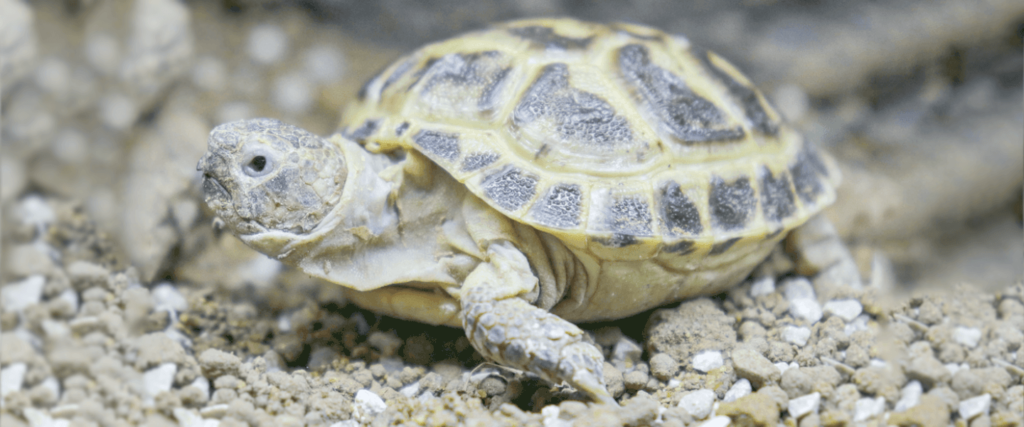
Horsfield tortoise diet
Horsfield tortoises are herbivorous so feed solely on vegetation. The ideal diet would provide variety in the form of leafy greens, garden weeds, fruit and vegetables. Many commercial Tortoise diets also exist, although we do not recommend them for use as a staple diet due to the lack of variety.
All fresh food offered to your Tortoise should be dusted with supplements according to a schedule to ensure that they are getting all of the required nutrients for healthy shell growth and to avoid serious health issues such as metabolic bone disease.
Here we recommend using a calcium-rich multivitamin such as Arcadia EarthPro-A, a calcium plus magnesium supplement on every fourth feed, such as Arcadia CalciumPro Mg and finally, a vitamin D3 supplement on every eighth feed such as Arcadia EarthPro RevitaliseD3.
Horsfield tortoise tank decoration
Many Tortoise tables have inbuilt hiding areas, however, if your enclosure does not, you will need to provide your Tortoise with a wide-entrance hiding cave or two. Another necessary piece of decor is a shallow feeding dish to help prevent substrate ingestion when feeding.
You should also fill your Tortoise enclosure with enrichment pieces in the form of tunnels, hills, foliage, rocks and bark pieces. Rougher pieces of decor will help to prevent extensive nail growth and also assist your Tortoise in it's shedding process.
It is important to move pieces of decor around and rearrange the enclosure from time to time, adding or removing pieces to provide enrichment and keep your Tortoise stimulated.
Horsfield tortoise hibernation
Horsfield tortoises would naturally hibernate throughout the winter months to avoid the extreme temperatures that would likely kill them. In captivity, we can begin hibernating our Tortoises when they reach around 2-3 years old, providing that they are large enough and have been checked for common signs of illness or infection.
For more detailed information regarding Tortoise hibernation, take a look through our dedicated Tortoise hibernation guide.
Alternative species
There are a few different species of Tortoise with very similar care requirements to the Horsfield, examples being the Mediterranean tortoises such as the Hermann's tortoise, the Spur-thighed tortoise and the Marginated tortoise.
If you're looking for something a little bigger or more specialist, a tropical species such as the Redfoot tortoise, or a desert species like the Leopard tortoise may be more to your taste.
If, however, a Horsfield tortoise sounds like exactly what you want, and you're local to us, why not see if we have any Horsfield tortoises for sale in our store?
Horsfield tortoise care at a glance
Common names: Horsfield tortoise, Russian tortoise, Central Asian tortoise, Four-clawed tortoise
Scientific name: Agrionemys horsfieldii, Testudo horsfieldii
Country: Central Asia
Captive-bred: Yes
Adult size: 12-20cm (5-8")
Natural habitat: Arid, desert habitats and mountainous areas
Housing: 150 x 90cm (5 x 3ft)
Ideal temperature: 30-32°C (86-89°F) (warm end); 22-25°C (71-77°F) (cool end)
UVI: 3-4
Ideal humidity: 40-50%
Diet: Herbivorous
Average lifespan: 80+ years
Personality: Docile
Easy of handling: Easy, more difficult with adults
Cohabitable: No
Horsfield tortoise shopping list
- 150 x 90cm (5 x 3ft) table or vivarium (minimum)
- Heat lamp fixture
- Mercury vapour lamp, basking lamp or ceramic heater
- Thermostat if required (none, dimming or pulse depending on heat source)
- T5 lighting kit if opting for separate heat and UVB
- Digital thermometer x2
- Water dish
- Food dish
- Substrate
- Hides and decor
- Supplements (multivitamin, calcium + mg and vitamin D3)
- Reptile safe disinfectant
- Cuttlebone/tortoise block
While you're thinking about caring for your new Horsfield tortoise, why not take a look through our range of Tortoise starter kits? Designed so that you can get everything you need to get started in one go, at a great price!
Becky Bates has always had a fascination with animals, particularly reptiles, amphibians, and invertebrates from a young age. A graduate of Zoology, she is a dedicated and experienced reptile keeper providing top-notch advice and care to Swell Reptiles customers. With her extensive experience with animal biology and behaviour, she understands the importance of promoting a healthy, safe, and happy environment for all animals.




